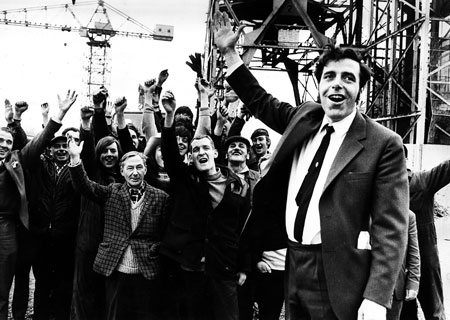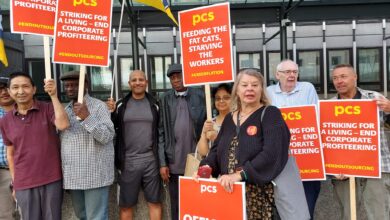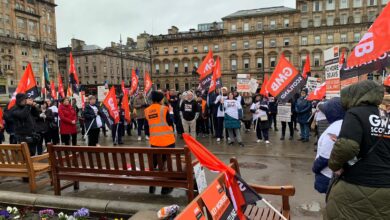50th anniversary: UCS work-in and the lessons for today

50 years ago, thousands of workers occupied shipyards along the Clyde and defeated plans for a massacre on jobs and trade union organisation by a vicious Tory government and greedy bosses. The prolonged industrial struggle of the Upper Clyde Shipbuilders (UCS) will rightly be celebrated by the trade union movement in Scotland this year. But what are the lessons of this battle for the new generation of trade unionists and workers’ reps in 2021? Matt Dobson explains.
In 1971 British capitalism, like today, was in a major economic crisis. Industries like shipbuilding were in decline.
In 1950, 50% of the world’s ships were built in Britain. By the time of the UCS struggle this had dropped to 5% as the capitalists shifted to air freight and lower cost production in Asia.
The Clydeside shipyard workers, in the summer of 1971, were enraged by the plans to close yards and sack thousands after the UCS consortium bosses had pocketed millions in state subsidies from Wilson’s Labour and then the Tory Heath government.
Ronnie Stevenson, a Glasgow activist in Socialist Party Scotland, gave a backdrop to these events, writing in 2010 in the aftermath of the passing of one of the main trade union leaders of UCS, Jimmy Reid.
“UCS was created by the amalgamation of five shipbuilders, who were brought under semi-public ownership under the Labour government of Harold Wilson in the 1960s. But with the election of the Ted Heath-led Tory government in 1970 the de-nationalisation of UCS was on the cards. The withdrawal of government support would have led to the decimation of the industry and the jobs of the 13,000 workers who relied on the yards. The government’s proposal was to slash the workforce to 2,500.”
UCS was a powerful centre of trade union organisation. Through its shop stewards and co-ordinating committee, union leaders had huge authority. These included Jimmy Reid, Sammy Barr and Jimmy Airlie, who were Communist Party councillors in Clydebank and Labour left activist Sammy Gilmour.
UCS shop stewards had secured hard won high standards of terms and conditions for their workers, seen as a real threat by bosses across Britain. Heath and the Tories hoped to break this on the way to opening up an offensive on wider sections of the working class.
Keith Dickinson came to Glasgow and the west of Scotland to report for the Marxist Militant newspaper – the predecessor of the Socialist – as the UCS struggle began.Writing in the Socialist on the 40th anniversary, in 2012, Keith commented:
“100,000 workers answered the call in June 1971 for a half-day strike by workers of Upper Clyde Shipbuilders (UCS) and there was a demonstration of 40,000 including supporters from all over Glasgow and Scotland and even other parts of Britain. These included 800 under the Carlisle Trades Council banner, women from the local biscuit factory in their overalls and nurses in their uniforms.”
flashpoint
“The dispute came to a head when the government announced on 29 July 1971 its intention to refuse any more subsidies and the appointment of a liquidator instead. He would oversee a plan to close two of the yards and sell them off, and eventually privatise the rest of the consortium.”
In response, Keith explains, a mass meeting of the “UCS Stewards Coordinating Committee decided that they should operate a work-in as opposed to a sit-in strike which had been raised at the full stewards’ meetings”.
Despite the serious limitations of this tactic it captured the imagination of many workers in Scotland and internationally.
Ronnie Stevenson highlights that “the UCS “work-in” – was effectively the taking over of the yards by the workers, who continued to produce ships – All the men and materials entering or leaving the yards were under the control of the shop stewards. It was a marvellous example of the power of the working class – with the government and the state powerless to respond”.
“There was a huge mobilisation of support among the working class of the west of Scotland, across Scotland as a whole as well as England and internationally. Donations to the work in came from shipyard workers in the Soviet Union and even from John Lennon.”
“The scale of the movement was shown by the huge demonstration that marched from George Square to Glasgow Green on Wednesday August 18th. Such was the pressure from the working class that the STUC were forced to convene the first special Congress in its history.
“The demo, on 18th August, was the biggest working class demonstration in Scottish history – 80,000 strong. With it being a Wednesday, workers stopped work and an estimated 200,000 took part in what was effectively a partial general strike.”
The words of Jimmy Reid, addressing mass meetings in the shipyards, summed up the discipline of the workers movement in struggle. “There will be no hooliganism, there will be no vandalism, there will be no bevvying”.
Ronnie points out: “He reminded them the whole world was watching and learning. Reid, Airlie, Barr and Gilmour also fought effectively against offers from the bosses and the Tories, supported by the Boilermakers leader McGarvey, that were made to save “two yards” in order to divide the workforce.”
“Through mass action and the solidarity of the working class across the country a victory was won.“The work-in continued for 16 months until October 1972. In the end the Tory government was forced into a U-turn and had to come up with £35 million in public money to maintain 5,000 jobs at UCS, in conjunction with a US company.”
the “work-in” tactic
Was the UCS tactic of a work-in rather than strike or sit-in occupation where workers stop production directly hitting their bosses profits a model?
UCS took place during a period of mass struggle for the working class in Britain. In fact there were 250 workplace occupations in the first three years of the 1970s, only two of these used the “work-in” tactic. Alongside this there was the heroic miner’s strike that brought down Heath’s Tory government including the successful mass picketing of the Saltley gate coke depot, walkouts over the dockers jailings and months of postal workers strikes.
Just a few miles along the Clyde in the Vale of Leven, while the UCS sit-in took place, in September 1971, a heroic occupation of 250 workers at the Plessey defence factory developed.
Workers having received their last pay packets sat-in and locked the bosses out, attempting to use the remaining machinery as a bargaining tool. They had the support of the local community and their convenor
Eddie McLafferty thanked Militant and Keith Dickinson for its consistent support, in contrast to the Morning Star and the Communist Party.
Militant pointed out why this strike and occupation was treated differently to the UCS “work-in”. “As distinct from the UCS ‘work-in’, the action of the Plessey workers has been greeted with great hostility from the management and the police, and this indicates the significance and important lessons to be learned from this struggle.
The Plessey workers recognise that it is a political struggle as well as industrial, and this can be seen from the banners all around the factory perimeter, unlike the UCS yards”.
The ideas of nationalisation and workers’ control were commonly discussed by workers in Britain and in the UCS stewards’ meetings, influenced of course by the revolutionary struggles of the working class in France, Italy and Portugal going on at the time.
It’s true the “work-in” captured the imagination of many workers, and the unity across the yards in carrying it out showed the authority of Reid and his comrades.
However, Keith Dickinson points out that Jimmy Reid and the Communist Party were wrong at the conclusion of the dispute in October 1971 to claim that this tactic by itself “lifted the working class of this country to a new level and a new dimension”.
There was real risk that the “work-in” tactic, with production continuing, could result in ships being finished and sent out and the liquidator, present the whole time in the yards, then implemented job losses.
The “work-in” while creating political problems for the Tories also saved them money and allowed them to run down the clock with negotiations.
Originally three hundred workers had been made redundant but during the sit-in they were paid out of the wages of their fellow workers and the huge donations from the workers’ movement.
It was sustainable for a period to get the movement nationally to support UCS with donations but this would have been completely unsustainable to replicate this approach with the huge number of other industries that were under threat.
While the “work-in” tactic was heroic and admirable it is very possible that strike action and an occupation stopping all production could have ended the dispute and saved the jobs sooner.
Keith Dickinson highlights that such a course of action “most importantly for the working class as a whole and the movement it would have demonstrated that nothing under capitalism can be produced without the workers – and an individual workforce can win on its own with community backing and class solidarity, particularly as in this case if they link it to the demand for the nationalisation of the industry under democratic workers’ management and control”.
Communist Party
But this was in fact diametrically opposed to the political aims and outlook of the Communist Party which adopted a reformist position. The Communist Party, rather than raising socialist nationalisation, sowed illusions in private buyers during UCS.
John Foster, a member of the Communist Party of Britain, wrote in the Morning Star on January 28 2021 that: “On top of building working-class unity across Britain (the Marxist strategy) was to create an anti-monopoly alliance… a structural split between the City of London and the big corporations on the one hand and the smaller regional businesses that actually comprised the government’s political base. Drive a wedge into that and the government would be in difficulty.
“This is what they did — under the slogan of Defend Scotland’s Economy ..the closure of UCS threatened to push hundreds of smaller supply firms towards bankruptcy. The liquidator appointed for UCS was responsible to them as creditors. An immediate tactical alliance was formed.
“In September the STUC broadened it. It organised public hearings that gave a voice to regional business leaders and Chambers of Commerce. Their resentments were made public. The Conservative Party in Scotland was paralysed. Then in early February the STUC and stewards organised a Scottish assembly for the whole of civic Scotland. The government agenda was lost.”
Of course the divisions in the ruling class Foster describes are real and should have been exploited to the maximum by the leaders of UCS.
But it is not the role of Marxists to create “anti-monopoly alliances” with sections of the capitalists. This CP line was just a continuation of the ‘Popular Front’ policy of alliances with the “progressive bourgeois”. A ruinous policy that led to the victory of fascism in Spain in the 1930s.
It was the power of the UCS workers taking action supported by workers internationally and the actions of other sections of the working class moving decisively into struggle that saved the jobs.
This cross-class alliance perspective of the CP influenced the “new realism” of the Kinnock Labour leadership and the national trade union leaders in the 80s.
It was a barrier to struggle and the need for the workers’ movement to rely on its own power rather than alliances with sections of the bosses.
Today, it is precisely fighting trade union leaderships that must be built based on confidence to mobilise workers against the offensive of the capitalists.
And that fighting industrially must be linked to a political programme to change society, build a new workers’ party and fight for socialism.



